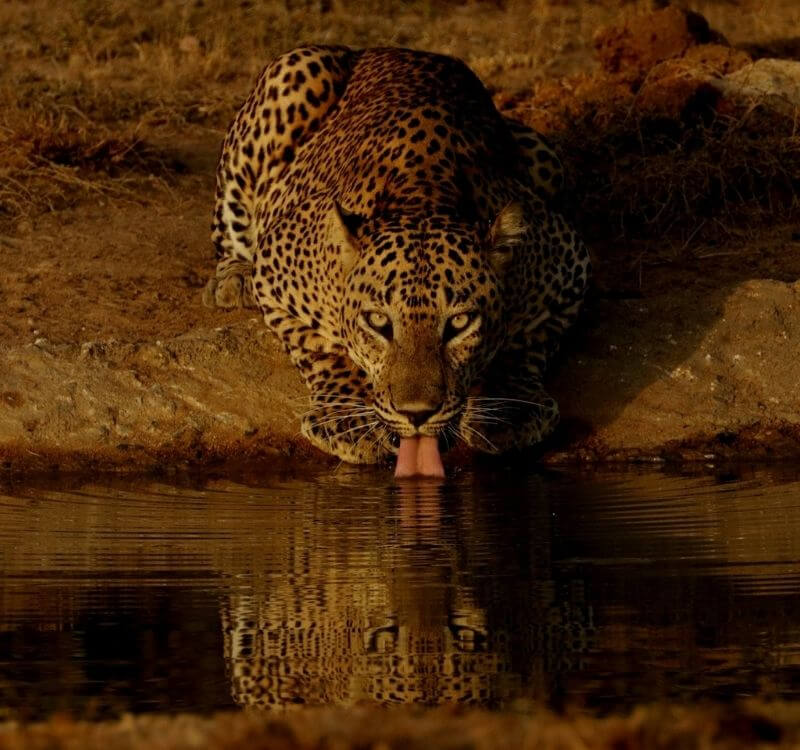Wilpattu National Park
Experience the Wilderness of Wilpattu, Sri Lanka
Experience Sri Lanka’s most elusive wildlife in the vast seclusion of Wilpattu National Park. Occupying a vast swathe of land bordering the copper-sand beaches of the north west coast, the ancient ruins of the Cultural Triangle and the Northern Province, this is Sri Lanka’s largest and oldest game reserve. Home to myriad endemic species, the park fosters sensational bird life, Asian Elephants, Sri Lankan Leopards, Sri Lankan Sloth Bears.
History of Wipattu
While Wilpattu was first designated a wildlife sanctuary as far back as 1905, it wasn’t until February 1938 that this 13,500-hectare park was elevated to national park status. Yet, its story begins much earlier than this. The copper shoreline of the reserve, specifically at Kudiramalai, a rocky promontory, is widely believed to have been the landing spot of the Indian Prince Vijaya in the 5th century BC. He married Princess Kuveni of Sri Lanka, and together they established the Sinhalese race. The region’s alternative name – Thambapanni or the ‘colour of copper’ – came about due to the reddish colour of the sand that stained the hands and feet of Prince Vijaya and his 700-odd followers when they came ashore. The ruins of Kuveni’s palace is just one of 68 archeological sites within Wilpattu National Park.
Where is Wilpattu?
Wilpattu National Park is in the north west of Sri Lanka, around 35km west of Anuradhapura and 32km north of Puttalam. It takes around 90-minutes to reach the reserve from Uga Ulagalla, and is around a 4-hour drive from Uga Residence in Colombo. From Wilpattu National Park’s main entrance at Hunuvilagama, the track weaves through beautiful lowland forest for around 10-kilometres before you reach the more open wildlife areas.
Topography of Wilpattu
‘Willu’ and ‘pattu’ broadly translate as the Land of the Lakes, and this is exactly what defines this beautiful reserve. In amongst the lowland forest, open scrubland and thick jungle lie up to 60 ‘villus’ – natural, shallow rainwater-collecting basins, which expand and contract with the seasons. Wildlife is drawn to these pristine waterholes and the lush grassy banks that surround them, which makes them prime spots for wildlife spotting throughout the year.
When to go to Wilpattu for a national park safari?
Wilpattu National Park is a year-round destination for wildlife safaris. The most popular time to visit is during the May to September dry season, and in early October when the onset of the drought and die-back of vegetation heightens wildlife-viewing in and around the many waterholes. The north eastern monsoon brings rainfall from October until December, after which the reserve is lush, green and beautiful – great clouds of butterflies are a highlight at the beginning of the year. Sloth bears love feasting on the intoxicating fruits of the palu trees in season between May and July, and therefore sightings are optimal at this time. The best wildlife sightings are early morning and evening, so be prepared to wake up early.
What wildlife can you see in Wilpattu?
Wilpattu National Park is home to Sri Lanka’s most exciting, longed-to-see wildlife. These include the elusive Sri Lankan leopard, the Asian Elephant and the Sri Lankan Sloth Bear alongside a supporting cast of spotted and sambar deer, crocodiles, mongooses and water buffalo. Leopard sightings are amongst the best in the country despite the reserve having a much less dense leopard population than Yala National Park. The aquatic features of the park also make this one of Sri Lanka’s best places for bird watching – some of the endemics include the Ceylon grey hornbill, the Ceylon Prakeet and the Red-backed woodpecker. You may also spy the brownish chicken-like Sri Lankan Jungle fowl, Sri Lanka’s national bird.
A quick guide to Wilpattu
The full extent of Wilpattu National Park is open to visitors, and this is eight times larger than Yala National Park’s Block I, which is where most of Yala’s game drives take place. As such, the chances of encountering masses of jeeps are much less likely. You need a little more time to explore Wilpattu – reaching the main, open areas of the reserve takes a good 45 minutes – though you can stay all day. Wilpattu National Park, partly due to its more remote north westerly location, sees much less tourism footfall than Yala which means that when you do sight a leopard, sloth bear or elephant, your jeep is likely to be the only one watching it. You can take your time and maximise your enjoyment of the Wilpattu safari experience.
Which is the best national park in Sri Lanka?
Sri Lanka’s 26 national parks are exceptional places for wildlife spotting and offer very different wildlife experiences. Two standout national parks in Sri Lanka are Yala and Wilpattu due to the sheer variety of resident wildlife. You can tick off Sri Lanka’s Big Three – leopards, elephants and sloth bears in one game drive. Yala’s dense leopard population has made it a world standout, however sightings of leopards in Wilpattu are also very strong throughout the year. Sloth bears may also be seen in both reserves, particularly in May and June. Elephants are resident in all of Sri Lanka’s national parks, however, Minneriya and Uda Walawe are two of the best reserves for sighting large herds of elephants. Birding enthusiasts will be drawn to Wilpattu National Park, as well as Yala and Bundala.
How to visit Wilpattu National Park
Both Uga Ulagalla and Uga Residence offer complete packages to Wilpattu National Park including transport to the reserve, the game drive, Wilpattu National Park entrance fees, a naturalist and tracker, meals, snacks and refreshments, and wildlife viewing equipment. You could also visit Wilpattu National Park when travelling between Ulagalla and Uga Residence.
What to wear on a jeep safari in Sri Lanka
Wear comfortable, breathable clothing in neutral, khaki and brown hues. It’s also a good idea to layer up since it can be cool in the early hours of the morning and then very hot and humid after the sun comes up. You may also need sun cream and sun hats.


